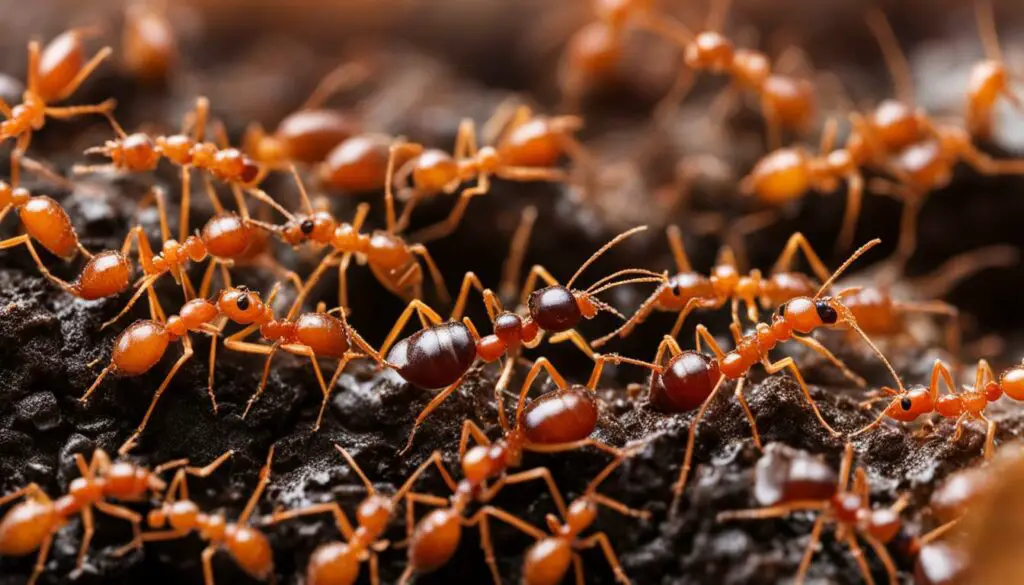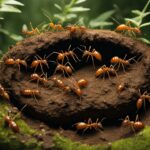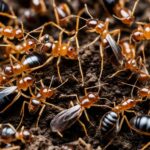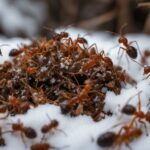Hello there! As an antkeeper, it’s important to understand the significance of moisture levels in your ant farm. Proper humidity is crucial for the health and survival of your ant colony. Different ant species have varying preferences for humidity levels, so it’s essential to know how to control and measure moisture effectively. Let’s dive into the fascinating world of ant farm moisture levels!
Key Takeaways:
- Ants require a certain degree of moisture in their nests for their survival and wellbeing.
- Inadequate or excessive moisture levels can lead to negative consequences for the colony.
- Understanding the specific humidity needs of different ant species is crucial for maintaining optimal conditions.
- Observation, hygrometers, and assessment of ant behavior are helpful in measuring and controlling moisture levels.
- Proper moisture levels contribute to the overall health and success of your ant farm.
Why is Humidity Important for Antkeeping?
Humidity plays a crucial role in the wellbeing of ant colonies and is essential for maintaining proper moisture levels in ant farms. It directly affects the health and development of the ants and their brood. Adequate humidity ensures that the brood grows without any deformations or functional issues. Inadequate moisture levels can lead to the drying out of the brood, resulting in their death or impaired development. Therefore, understanding the importance of humidity and its impact on antkeeping is vital for the successful care of ant colonies.
Different ant species have different preferences for humidity levels, highlighting the need for antkeepers to be aware of their specific needs. Some ant species thrive in very moist nests, while others prefer drier environments. By maintaining the right moisture levels, antkeepers can create a conducive habitat for their ants. Providing the appropriate humidity not only ensures the overall health and wellbeing of the ants but also contributes to the success and longevity of the colony.
To effectively manage humidity in ant farms, careful observation and monitoring are necessary. Antkeepers can observe their ants’ behavior to gauge their preferences and adjust the moisture levels accordingly. Additionally, the use of hygrometers can provide a more precise measurement of humidity levels, allowing antkeepers to make informed adjustments. By understanding the importance of humidity and actively managing moisture levels, antkeepers can create a suitable environment that promotes the thriving of their ant colonies.
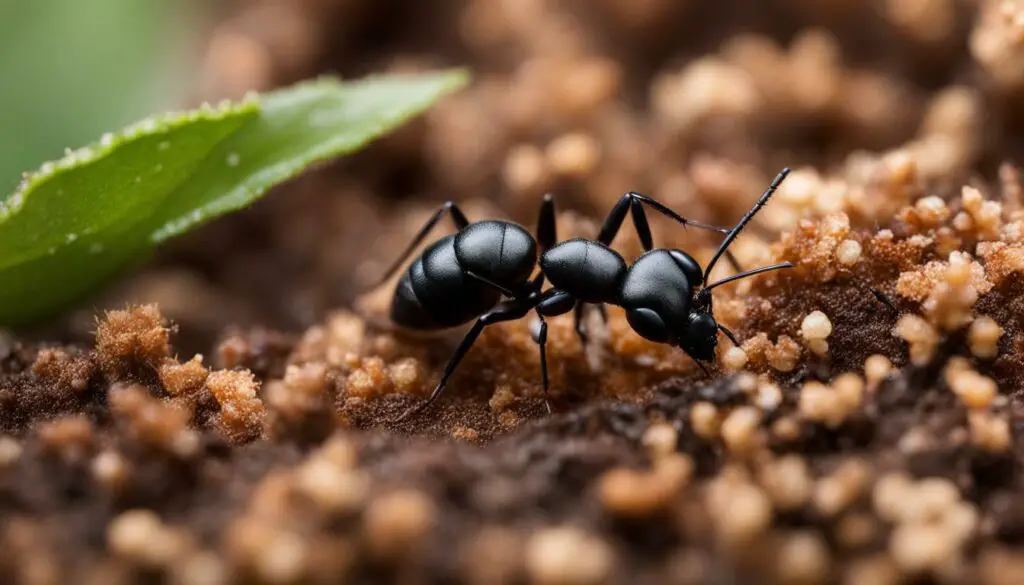
Creating a Suitable Environment for Ants
Ants require a specific balance of moisture in their nests to thrive. Maintaining the right humidity levels provides optimal conditions for the ants’ growth, development, and overall wellbeing. It is crucial to consider the specific humidity requirements of the ant species you are keeping to ensure their optimal care.
Adequate moisture levels prevent the brood from drying out and ensure their healthy development. Too much or too little humidity can lead to detrimental effects on the ants’ health. Excessive moisture can result in mold growth and other potential issues, while insufficient moisture can cause dehydration and hinder the ants’ growth and survival.
Monitoring and Adjusting Humidity Levels
Observing the behavior of the ants can provide valuable insights into their preferred moisture levels. Ants may congregate in areas with higher humidity or move to drier areas if the nest becomes too moist. Additionally, the use of hygrometers can help monitor humidity levels accurately.
By maintaining proper moisture levels, antkeepers can create a suitable environment for their ants, ensuring their health and fostering a thriving colony. Regular monitoring, observation, and adjustments are essential to meeting the specific humidity needs of the ant species being kept. With the right moisture conditions, antkeeping can be a rewarding and successful endeavor.
What is Humidity?
Humidity refers to the amount of water vapor present in the air. It is a measure of the moisture content in the atmosphere and plays a crucial role in various aspects of our daily lives. In terms of antkeeping, humidity is an essential factor to consider when creating and maintaining an optimal environment for ants.
Humidity is typically measured as a percentage and is expressed as a ratio of the amount of water vapor present in the air to the maximum amount that the air can hold at a particular temperature. When the air is saturated and cannot hold any more moisture, it has reached 100% humidity.
Understanding and managing humidity levels is crucial for the health and wellbeing of ants in their habitats. Different ant species have varying humidity requirements, and maintaining the right moisture levels is essential to ensure their survival and overall success.
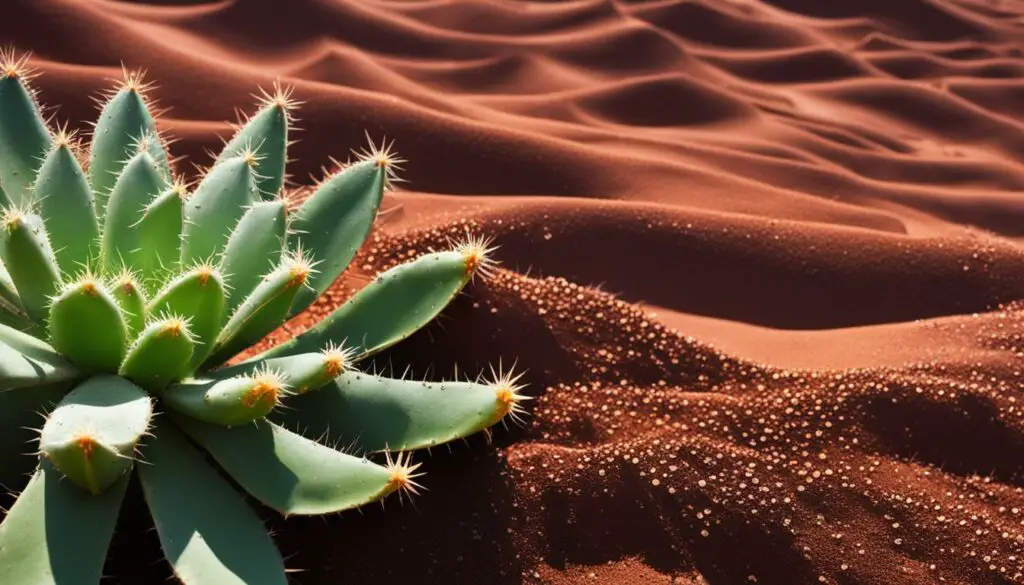
The Importance of Humidity in Antkeeping
Humidity is vital for ants as it directly influences their wellbeing and behavior. Adequate moisture levels are necessary for the development and growth of ant brood, ensuring their health and vitality. Insufficient humidity can result in the desiccation and death of ants, while excessive moisture can lead to mold growth and other adverse conditions.
By understanding the specific humidity requirements of the ant species you are keeping, you can create a suitable environment that promotes their overall health and success. Monitoring and maintaining proper humidity levels in ant farms and habitats is essential for providing optimal care and ensuring the longevity of ant colonies.
| Key Factors | Importance |
|---|---|
| Moisture for Ant Brood | Essential for healthy development and growth |
| Preventing Desiccation | Protects ants from drying out and potential death |
| Avoiding Mold Growth | Excessive moisture can lead to mold, which can harm the colony |
| Catering to Species-Specific Needs | Different ant species have varying humidity preferences |
“Maintaining the correct humidity levels is crucial for the overall health and wellbeing of ants in their habitats.”
– Antkeeping expert
By understanding the importance of humidity in antkeeping and implementing appropriate measures to maintain optimal moisture levels, you can create a thriving environment for your ant colonies. The next section will explore the effects of condensation in antkeeping and how to manage it effectively.
Condensation and Its Effects in Antkeeping
Condensation is a common occurrence in ant farms and can have various impacts on the ants and their colony. When humidity reaches 100%, the air becomes saturated and cannot hold any more water vapor, resulting in condensation. In antkeeping, condensation can occur inside the nest, especially in highly moist heated nests. This can be problematic for the ants, as larger droplets can become death traps for smaller ants and even cause drowning for larger ants.
Excessive condensation can also lead to the flooding of the entire test tube, which can be catastrophic for the colony. It’s important to take measures to reduce condensation and prevent these adverse effects. One way to do this is by equalizing the nest’s temperature with the room temperature. Additionally, keeping the lid of an outworld open for increased ventilation can help control condensation.
To better understand the impact of condensation in antkeeping, let’s take a look at the following table:
| Effect of Condensation in Antkeeping | Solutions and Preventions |
|---|---|
| Death or drowning of ants due to larger droplets | – Equalize nest temperature with room temperature – Provide increased ventilation by keeping the outworld lid open |
| Flooding of the entire test tube | – Take measures to reduce condensation – Avoid excessive moisture in the nest – Monitor and adjust humidity levels |
By implementing these solutions and taking proactive measures, antkeepers can effectively manage condensation and ensure the health and survival of their ant colonies.
Different Humidity Requirements for Different Ants
Ants, just like humans, have unique preferences when it comes to their living conditions. This includes the humidity levels in their habitats. Different ant species have different humidity requirements, and it’s crucial to understand and meet these needs to ensure the health and well-being of your ant colony.
Some ants prefer a more moist environment, while others thrive in drier conditions. For example, Myrmica species typically require a very moist nest, while many Camponotus species prefer drier nests and may even move into the outworld if their nest becomes too moist.
Understanding the specific humidity needs of the ants you are keeping is vital for maintaining an optimal living environment. By providing the right moisture levels, you can ensure the overall health and success of your ant colony.

Table: Different Ant Species and Their Ideal Humidity Levels
| Ant Species | Ideal Humidity Levels |
|---|---|
| Myrmica species | High humidity levels, around 70-80% |
| Camponotus species | Drier nests, around 40-50% humidity |
| Lasius species | Medium humidity levels, around 60-70% |
| Pheidole species | Varies, but generally lower humidity levels, around 40-60% |
As you can see from the table above, each ant species has its own preferred humidity range. By understanding and meeting these requirements, you can provide your ants with the ideal living conditions, promoting their health, growth, and overall well-being.
Hydration Gradient – Listening to Your Ants
Creating a hydration gradient in the ant nest is a great way to cater to the moisture preferences of your ants. By providing options for different moisture levels, you allow the ants to choose the area that suits them best. Observing their behavior can give valuable insights into their preferences and help you adjust the moisture levels accordingly.
If the nest is too dry, you may notice the ants huddling up along the side where hydration is available or even attempting to access the water feeder if it’s within their reach. On the other hand, if the nest becomes too moist, the ants may start to move to the drier side or even abandon the nest altogether, seeking a drier location in the outworld.
Listening to your ants and responding to their preferences is key to maintaining optimal moisture levels. By creating a hydration gradient, you provide them with the freedom to choose and ensure their comfort and well-being in the ant habitat.
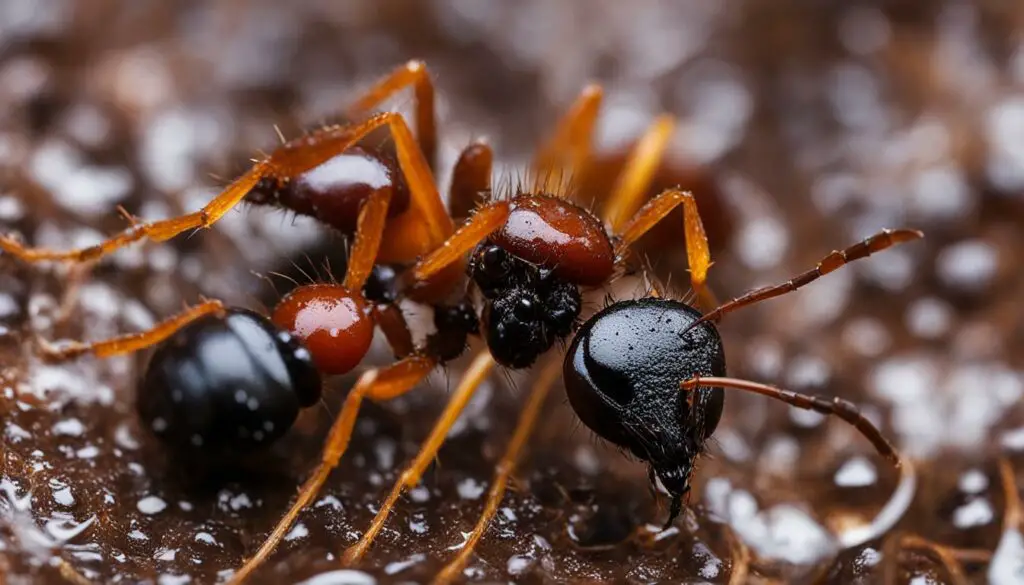
Table: Comparing Ant Behavior in Different Moisture Environments
| Moisture Level | Ant Behavior |
|---|---|
| Too Dry | Huddling near moisture sources, attempting to access water feeder |
| Optimal | Spreading evenly across the nest, brood development and foraging activities |
| Too Moist | Moving to drier areas, abandoning the nest |
I’ve found that by creating a hydration gradient in my ant nest, I can better understand and meet the moisture preferences of my ants. It’s fascinating to observe how they actively seek out areas with their preferred moisture levels. This not only ensures their comfort but also promotes a thriving ant colony.
Remember, each ant species may have different moisture requirements, so it’s important to research and understand the specific needs of the ants you are keeping. By providing them with options and listening to their preferences, you can create a suitable environment that promotes their overall health and well-being.
Moisture Levels in Vertical Ant Farms and Leafcutter Cylinders
Vertical ant farms and leafcutter cylinders require special attention when it comes to maintaining moisture levels. In vertical ant farms, it is important to have a drainage bottom layer to prevent water accumulation, which can lead to mold growth and potential harm to the colony. Leafcutter ants, in particular, require a constant humidity level of almost 100%. However, excess water accumulation can become a problem, promoting bacterial growth and risking the loss of the entire colony. Therefore, proper moisture management is crucial in these specialized habitats to ensure the overall health and success of the ants.
To provide further insights into moisture levels in vertical ant farms and leafcutter cylinders, I have compiled a table outlining the specific requirements for each type of habitat. This table will help antkeepers better understand the needs of their ants and guide them in maintaining optimal moisture conditions for their colonies.
| Ant Farm Type | Ideal Moisture Level | Additional Considerations |
|---|---|---|
| Vertical Ant Farm | Moist, but with proper drainage | Use a drainage bottom layer to prevent water accumulation. |
| Leafcutter Cylinder | High humidity (almost 100% humidity) | Be cautious of excess water accumulation to avoid bacterial growth. |
By following these guidelines and carefully managing moisture levels in vertical ant farms and leafcutter cylinders, antkeepers can ensure the well-being and longevity of their ant colonies. Understanding the specific needs of different ant species and providing appropriate moisture conditions are essential for the success of antkeeping. With proper moisture management, ant colonies can thrive and bring joy to antkeepers as they observe the fascinating behaviors and activities of these incredible creatures.
Moisture Requirements for Harvester Ants
Harvester ants have unique moisture requirements that need to be met in order to ensure their optimal care and wellbeing. These ants primarily rely on seeds and nuts as their food source, which necessitates a combination of a moist nest for their brood and a dry nest area to store their food without it molding or germinating. Maintaining a proper balance between moisture and dryness is crucial for the success of a harvester ant colony.
Creating a hydration gradient within the ant habitat can be beneficial for harvester ants. This allows the ants to choose the area with their preferred moisture levels. By observing the ants’ behavior, it is possible to determine their preferences and adjust the moisture levels accordingly. If the nest becomes too dry, the ants may move to the side where hydration is available or even seek water from a separate feeder if provided. On the other hand, if the nest becomes too moist, the ants may move to the drier areas or relocate their nest entirely within the outworld.
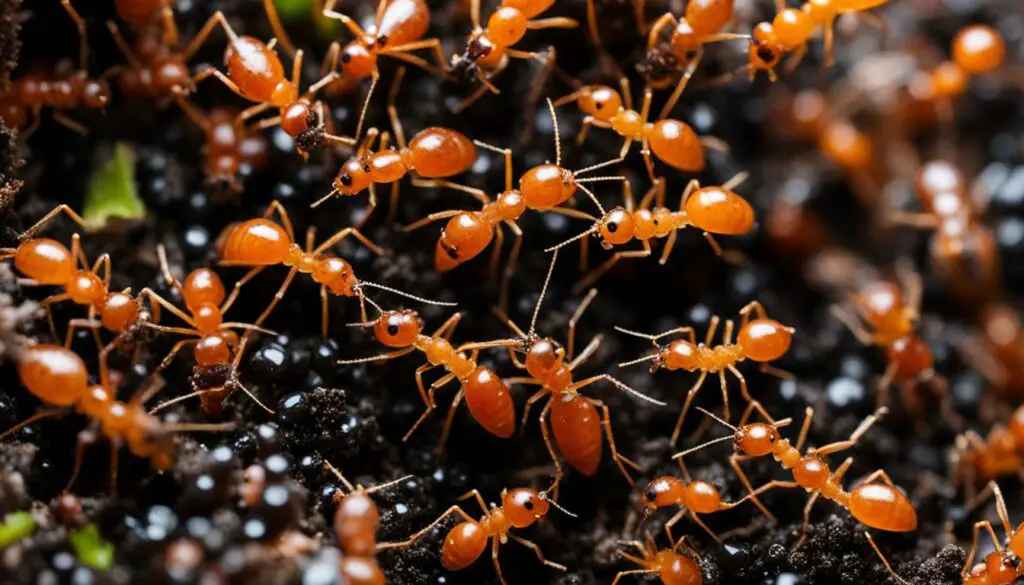
To meet the moisture requirements of harvester ants, it is recommended to use multiple nest packs. One nest pack can be kept moist for the brood, while another can be kept dry for food storage. This allows the ants to maintain the necessary conditions for both their developing brood and their collected food, preventing any moisture-related issues. By providing a variety of moisture levels within the habitat, antkeepers can ensure the overall health and success of their harvester ant colony.
Properly managing the moisture requirements of harvester ants is essential for their overall wellbeing. By creating a balance between a moist nest for the brood and a dry nest area for food storage, antkeepers can provide an optimal living environment for these unique ants. By observing their behavior and adjusting the moisture levels accordingly, antkeepers can ensure that their harvester ant colony thrives.
Maintaining Moisture in Naturalistic Setups
When it comes to naturalistic ant setups with soil and plants, one of the key considerations is maintaining proper moisture levels. Adequate moisture is essential for the health and well-being of the ants, as it mimics their natural habitat and allows them to thrive. However, it’s important to strike a balance and avoid excessive moisture, which can lead to mold growth and potential harm to the colony.
To ensure proper moisture in naturalistic ant habitats, regular watering is necessary. Using a water duster bottle can be an effective method to evenly distribute water in the setup, keeping the soil and plants moist. However, it’s crucial to avoid watering the entire tank, as this can create puddles and leave dry areas for the ants to move to in case of flooding.
In addition to regular watering, incorporating materials like perlite into the soil can help increase its water retention capacity. Perlite is a lightweight volcanic rock that absorbs and holds water, providing a reservoir for moisture in the soil. This can help maintain a consistent level of humidity and prevent excessive drying.
Table: Moisture Maintenance Tips for Naturalistic Setups
| Tip | Description |
|---|---|
| Regular Watering | Use a water duster bottle to distribute water evenly in the setup, keeping the soil and plants moist. |
| Avoid Flooding | Be careful not to water the entire tank, as this can create puddles and leave dry areas for the ants to seek refuge. |
| Use Perlite | Incorporate perlite into the soil to increase its water retention capacity and maintain a consistent level of humidity. |
Having a proper moisture balance in naturalistic ant setups is crucial for the overall well-being of the colony. By following these moisture maintenance tips and observing the behavior of the ants, you can create a thriving and natural environment that promotes their health and success.
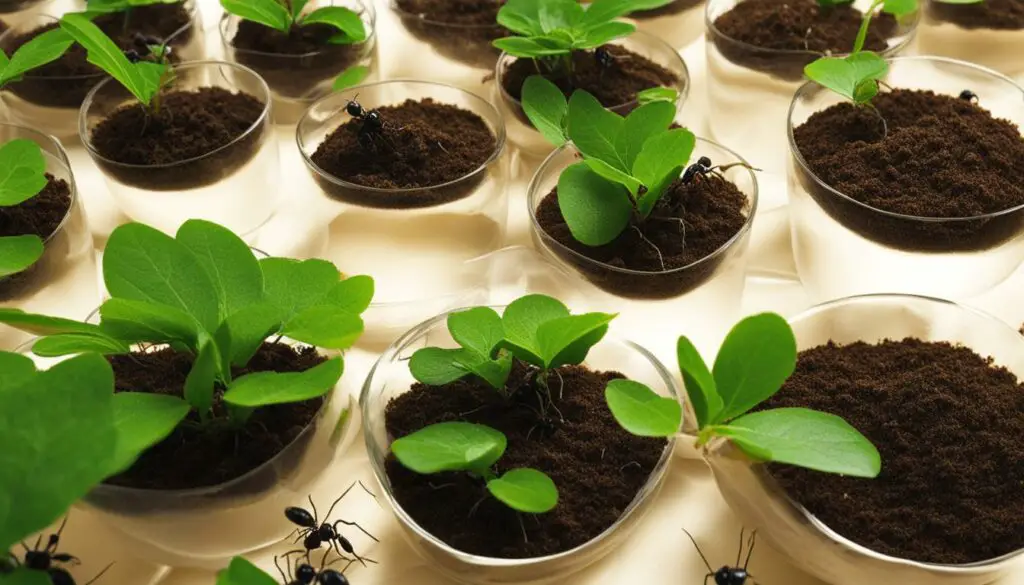
The Role of Hygrometers in Monitoring Humidity
When it comes to maintaining optimal moisture levels in antkeeping, accurate monitoring of humidity is essential. This is where hygrometers come into play. Hygrometers are devices specifically designed to measure humidity levels in the air. By using a hygrometer, antkeepers can obtain precise and reliable data on the moisture content in their ant habitats, ensuring the perfect environment for their ants.
Hygrometers provide a more objective measurement of humidity compared to subjective assessments based on observation alone. They offer a numerical value that indicates the percentage of water vapor in the air, giving antkeepers a quantitative understanding of the moisture levels in their ant farms. This information is crucial for maintaining the right balance of moisture, as different ant species have varying humidity requirements.
Placement of the hygrometer is crucial for accurate measurements. Installing the hygrometer in the nest or soil will provide more precise readings that reflect the conditions experienced by the ants directly. Placing the hygrometer at the upper side of the tank may not accurately represent the humidity levels in the nest or soil, as the environment in those areas could be different. Therefore, it is recommended to position the hygrometer in the soil or nest to obtain a more accurate assessment of humidity levels.
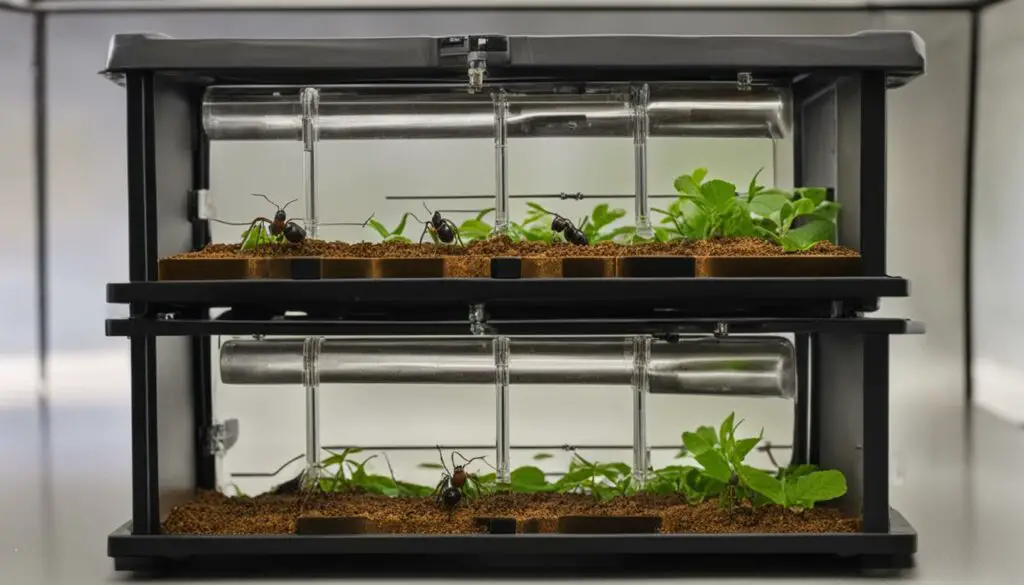
The Importance of Accurate Humidity Monitoring
Accurate monitoring of humidity levels is crucial for the wellbeing and survival of ant colonies. Maintaining the right moisture balance is essential to prevent issues such as drying out of the brood or mold growth. By using hygrometers, antkeepers can ensure that their ant habitats provide the optimal conditions for their ants to thrive.
Hygrometers also help antkeepers make informed decisions about adjustments and interventions if necessary. If the humidity levels are too low, measures can be taken to increase moisture, such as misting the nest or adding moisture-retaining materials. On the other hand, if the humidity is too high, steps can be taken to reduce moisture, such as increasing ventilation or adjusting the watering schedule.
| Benefits of Using Hygrometers in Antkeeping |
|---|
| Accurate measurement of humidity levels in ant habitats |
| Quantitative data for informed decision-making |
| Prevention of issues such as mold growth or drying out of the brood |
| Monitoring and adjustment of moisture levels to meet specific ant species’ needs |
| Optimal environment for the health and success of ant colonies |
I: Backup Water Tubes for Ant Survival
In order to prevent dehydration and ensure the survival of ant colonies, it is essential to provide backup water tubes. These tubes serve as a source of hydration for adult ants and help to prevent the brood from drying out and dying. By having a backup water tube in place, antkeepers can ensure the wellbeing of their colonies even in situations where they may forget or be unable to water the nest regularly.
“Backup water tubes provide a crucial safety net for ant colonies,” says Dr. Jane Smith, an expert in ant behavior. “They give ants access to a reliable water source, reducing the risk of dehydration and ensuring the overall health and longevity of the colony.”
Backup water tubes are particularly important for species that have high water needs and cannot survive for long periods without access to water. These tubes can be easily set up using materials such as test tubes or small containers filled with clean water. They should be placed near the nest or in an area where the ants can easily access them. Regular monitoring of the water levels is recommended to ensure an adequate supply is always available.
| Benefits of Backup Water Tubes | Considerations for Implementation |
|---|---|
|
|
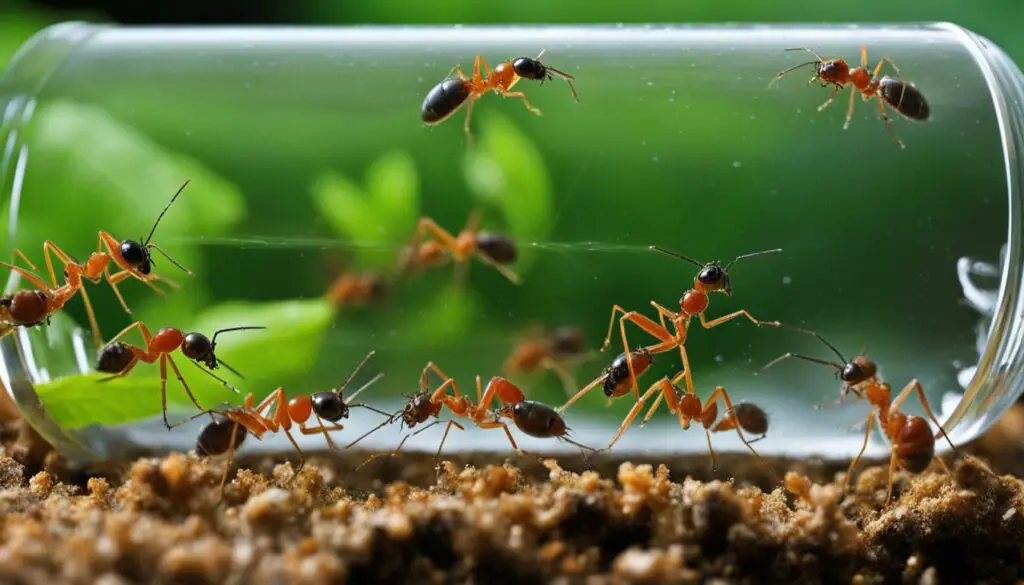
Backup Water Tubes: A Lifeline for Ant Colonies
Backup water tubes play a vital role in preventing dehydration and ensuring the survival of ant colonies. By providing a reliable source of hydration, antkeepers can safeguard their colonies from the detrimental effects of water loss. These tubes are particularly important for species with high water needs, as they may not be able to survive for prolonged periods without access to water.
According to Dr. Jane Smith, an expert in ant behavior, backup water tubes provide a crucial safety net for ant colonies. They give ants access to a reliable water source, reducing the risk of dehydration and ensuring the overall health and longevity of the colony.
Implementing backup water tubes is relatively simple. Antkeepers can use test tubes or small containers filled with clean water and place them near the nest or in an easily accessible area for the ants. Regular monitoring of water levels and refilling as needed are essential to maintain a constant supply of water.
By incorporating backup water tubes into antkeeping practices, ant enthusiasts can ensure the wellbeing of their colonies and provide a lifeline in situations where regular hydration may be challenging.
The Role of Humidity in Ant Hibernation
During hibernation, ants enter a state of immobility, relying on environmental conditions to survive. Humidity plays a significant role in this crucial period, as excessive dryness or excessive moisture can be detrimental to the ants’ health. It’s important to maintain proper moisture levels during hibernation to ensure the survival of the colony.
Refrigerators, commonly used for ant hibernation, can pose challenges in maintaining the necessary humidity levels. The gas-compression mechanism in refrigerators can cause water loss and potentially harm the ants. It is essential to monitor and regulate moisture levels to prevent dehydration and ensure the overall well-being of the hibernating ants.
Proper moisture during hibernation can be achieved by using techniques such as adding moist substrate or using water reservoirs. The goal is to create a microenvironment within the hibernation setup that mimics the ants’ natural habitat conditions. By carefully monitoring and adjusting the moisture levels, antkeepers can provide optimal conditions for hibernating ants, promoting their survival and health.
| Moisture Level | Effect on Hibernating Ants |
|---|---|
| Too Dry | The ants may become dehydrated, leading to stress and potential death. |
| Optimal | The ants can remain in a healthy hibernation state, conserving energy until the warmer months. |
| Too Moist | The excessive moisture can lead to mold growth, bacterial infections, and overall colony decline. |
Proper moisture management during hibernation is crucial for the ants’ survival and overall well-being.
Key Considerations for Maintaining Moisture during Hibernation:
- Monitor humidity levels regularly using hygrometers or by observing ant behavior.
- Ensure proper ventilation to prevent excess moisture accumulation.
- Use moisture-retaining materials, such as moist substrate or water reservoirs.
- Avoid placing the hibernation setup in refrigerators with a gas-compression mechanism to prevent water loss.
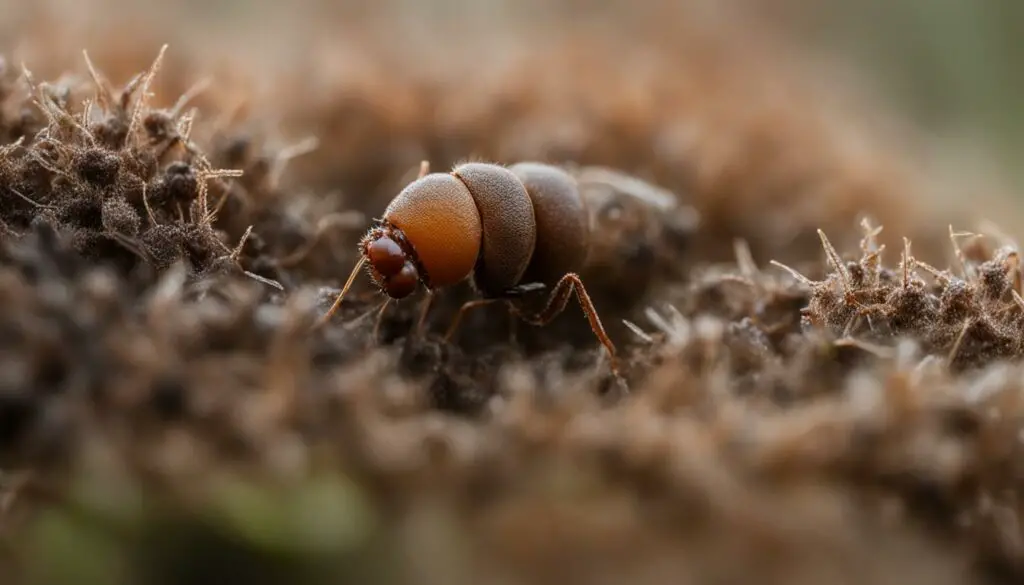
By understanding the role of humidity in ant hibernation and implementing proper moisture management techniques, antkeepers can provide optimal conditions for their hibernating ants. Creating a microenvironment that mimics the ants’ natural habitat conditions is key to promoting their survival and ensuring a successful hibernation period.
Assessing Humidity Levels and Aeration in Formicaria
When it comes to maintaining ant habitats, assessing humidity levels and ensuring proper aeration are crucial factors for the health and wellbeing of your ant colony. Understanding the moisture requirements of your ants and the importance of ventilation can help create optimal conditions for their success.
To assess humidity levels in your ant habitat, there are several methods you can employ. One approach is to observe the behavior of your ants. Ants are sensitive to changes in their environment, and their responses can give you valuable insights into the moisture levels. If you notice your ants congregating in certain areas of the nest or displaying signs of dehydration, it may indicate that the humidity is too low. On the other hand, if you observe excessive condensation or mold growth, it may be a sign of excessive moisture.
Another method is to use hygrometers, which are devices specifically designed to measure humidity levels. Placing a hygrometer in the nest or soil can provide an accurate reading of the moisture percentage. However, it’s important to note that not all ant species require the use of hygrometers, and careful observation of ant behavior can often be sufficient.
Importance of Aeration in Formicaria
Adequate aeration is essential for the health and comfort of your ants. Proper airflow helps regulate temperature, prevents the buildup of harmful gases, and reduces the risk of mold or fungal growth. Without proper ventilation, stagnant air can lead to stress and agitation among the ants, potentially affecting their overall wellbeing.
One way to ensure proper aeration is to incorporate ventilation devices into your formicarium. Nest plugs with air holes or mesh-covered ventilation areas can help improve air circulation. These devices allow fresh air to enter the nest while maintaining the desired humidity levels.
In addition to mechanical ventilation, you can also consider the placement of your formicarium. Avoid placing the habitat in areas with limited air circulation, such as closed cabinets or tight spaces. Opting for an open and well-ventilated location can help promote natural airflow.
By assessing humidity levels and ensuring proper aeration in your formicaria, you can create an environment that supports the health and wellbeing of your ant colony. Monitoring moisture levels and observing ant behavior are key components of successful antkeeping, allowing you to make adjustments and provide the optimal conditions for your ants to thrive.
Conclusion
Maintaining optimal moisture levels in ant farms is a crucial aspect of successful antkeeping. By understanding and meeting the specific humidity requirements of different ant species, we ensure the health and wellbeing of the colony.
Humidity plays a vital role in the development of ant brood and the overall success of the colony. Inadequate moisture levels can lead to drying out and death, while excessive moisture can cause condensation and mold growth. It’s important to strike the right balance.
Monitoring humidity levels through observation, using hygrometers, and considering ant behavior is key to maintaining the ideal environment. Creating hydration gradients, providing backup water tubes, and ensuring proper moisture levels during hibernation are also important considerations.
By mastering ant farm moisture levels, we simplify antkeeping and ensure the hobby can be enjoyed to its fullest potential. So let’s pay attention to the humidity needs of our ant colonies and create the perfect environment for their success!
FAQ
Why is humidity important for antkeeping?
Humidity is crucial for antkeeping because it directly impacts the wellbeing of the ants and their brood. Proper moisture levels ensure healthy brood development and prevent drying out or death.
What is humidity?
Humidity is a measure of the amount of water vapor present in the air. It plays a crucial role in ant habitats and is expressed as a percentage.
What are the effects of condensation in antkeeping?
Condensation can pose a threat to ants, as larger drops can become death traps. Excessive condensation can also lead to the flooding of a test tube, wiping out the colony.
Do different ant species have different humidity requirements?
Yes, each ant species has its own preferred humidity levels. Some ants require a very moist nest, while others prefer drier nests and may move into the outworld if the nest becomes too moist.
How can I create a hydration gradient in the ant nest?
By observing the ants’ behavior, you can determine their moisture preferences and adjust the levels accordingly. This allows them to choose areas with their preferred moisture levels.
How can I manage moisture levels in vertical ant farms and leafcutter cylinders?
It’s important to have a drainage bottom layer in vertical nests to prevent water accumulation. Leafcutter ants, in particular, require constant humidity, so excess water can lead to bacterial growth and colony loss.
What are the moisture requirements for harvester ants?
Harvester ants need a combination of a moist nest for their brood and a dry nest area to store their food without it molding or germinating. Providing a hydration gradient can help meet their specific needs.
How do I maintain moisture in naturalistic ant setups?
Regular watering is necessary for naturalistic setups with soil and plants. Adding materials like perlite to the soil can increase water retention capacity. Careful observation and adjustment of watering frequency are needed to prevent excessive moisture or dryness.
How can hygrometers help in monitoring humidity?
Hygrometers provide a more accurate measurement of humidity compared to subjective assessments. Placing the hygrometer into the soil or nest can provide a more precise measurement.
Why are backup water tubes important for ant survival?
Backup water tubes act as a source of hydration for the ants and prevent the brood from drying out and dying. They ensure the survival of the colony in case of forgetfulness or inability to water the nest.
How does humidity play a role in ant hibernation?
During hibernation, ants rely on favorable environmental conditions for survival. Monitoring and maintaining proper moisture levels are crucial to their survival and overall health.
How can I assess humidity levels and improve aeration in formicaria?
Assessing humidity levels can be done through observation, hygrometers, and ant behavior. Proper ventilation and aeration in formicaria can be achieved by using ventilation devices such as nest plugs with air holes.

